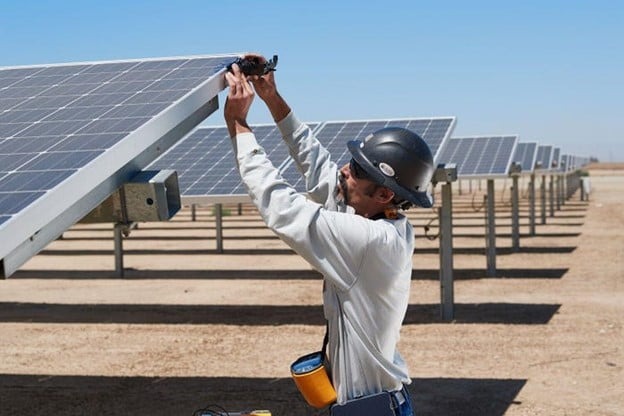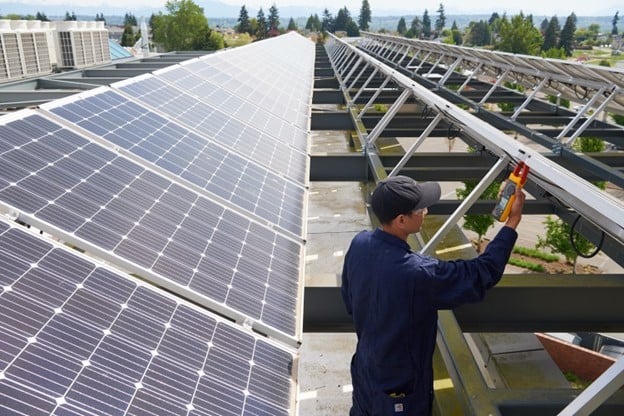What Solar Panel Technicians Can Learn from Gardeners
Ground faults are among the most common, persistent, and frustrating issues in the solar industry. Until recently, technicians have relied on the cumbersome “brute force” approach to pinpointing ground faults … but that entails time, labor, and risk. What if there’s a better approach?
It's time for solar panel technicians to start thinking like gardeners.
Thanks to technological advancements, today’s solar technicians have the tools to root out ground faults just as efficiently as gardeners root out aphids and weeds. And that means safer, more productive solar arrays, with a significant increase in uptime.
Let’s talk about exactly why we need a new way of thinking about ground faults, what we can learn from the timeless wisdom of gardeners, and how to implement that wisdom.

Ground faults: The “pests” of the solar world
Ground faults occur when there’s an unintended connection between a current-carrying conductor in your solar array and a metal part that's connected to the earth. Typically, that means a module frame, a piece of racking, or a conduit. Faulty wiring, damaged insulation, moisture, and even animal activity can all cause ground faults. It’s a common issue precisely because there are so many potential causes.
Whatever the cause, ground faults pose a significant danger. A ground fault sends current flowing through frames, or racking, which can lead to serious injuries if people come into contact with those energized metal parts. Ground faults can also cause arc faults, which can lead to fires.
Today, solar inverters are equipped with built-in ground fault detection and interruption devices that automatically shut down the inverter when a ground fault occurs. This much-needed safety measure saves lives and protects equipment. However, it doesn’t pinpoint the exact location of the ground fault.
Traditionally, locating ground faults has been an intensely challenging process involving hours of painstaking inspections. Once the fault is isolated, making repairs is relatively easy, but pinpointing the ground fault location has been such a challenge that technicians have often chosen to disable circuits rather than spend the time tracking down and repairing the fault. That’s an understandable choice. As any gardener will understand, however, it’s not a sustainable one.
Gardening 101: Don’t ignore the pests
Suppose there’s a gopher (or woodchuck, as we call them in Vermont) attacking the tomatoes in your garden. Obviously, you’re not going to just put up a fence around those tomatoes and hope for the best, crossing your fingers that your furry friend stays away from the fenced-in area and also avoids your unfenced basil plants. (Spoiler: he won’t.)
And yet, that’s essentially what solar operators have been doing with ground faults.
As we’ve seen, operators become aware of a ground fault when the inverter shuts down, leaving you with a solar array that is suddenly not producing power. At this point, technicians have a choice: they can spend hours walking the array to find and repair the string with the ground fault, or they can simply take the circuit off-line. Most of the time, the cost-benefit analysis makes shutting down the circuit feel like the right choice. The traditional form of ground testing is dangerous; it leaves technicians exposed to energized equipment and potential arc fires.
The traditional “brute force” troubleshooting process is also time-consuming and tedious, which drives up maintenance costs and increases the possibility of human error. In sum, it requires the technicians to walk out into the field with a detailed map and spend hours testing, measuring, and calculating, all while facing the risk of an electrical or fire hazard.
No wonder technicians often prefer to isolate the circuit.
Here's the problem, though: Shutting off the circuit and restarting the inverter doesn’t address the root cause of your ground fault, any more than fencing off the tomato plants solved the problem of your gopher. You’re left with a less productive solar array and a faulty string that will continue to cause both financial and safety problems, probably in the near future.

Gardening 102: Protect your output
A good gardener knows how to protect their crops and make the most of every harvest. Solar operators need to learn this lesson as well.
Shutting down a circuit (instead of finding and correcting the ground fault) is a short-term solution that causes long-term problems. It means that your solar array isn’t producing as much power as it could. Most solar operations and maintenance (O&M) providers have service agreements that subject them to penalties if the installation doesn’t meet production goals; a partial shutdown can result in fines for the O&M provider to compensate the system owner for the loss of revenue due to reduced energy production.
Shutting down circuits without fixing the underlying ground fault can also create significant safety issues. If a secondary fault develops nearby, it often creates a circular current that runs through the faulty string, potentially causing hazardous fires. It's a conundrum.
Failing to resolve ground faults causes production losses, penalties, and safety hazards. On the other hand, using traditional methods to pinpoint ground faults is expensive, time-consuming, and dangerous. Fortunately, the solution is already at hand, in the form of new ground fault detection technology.
Gardening 103: Use the right tools for the job
Whether it’s a trowel or a tractor, a good gardener knows how to choose and use the right tools for the job.
Today, solar technology has advanced to the point where technicians can zero in on the root cause of each ground fault quickly, eliminating the old, slow, brute-force troubleshooting methods. Best of all, the new tools are non-contact, allowing technicians to complete their work safely. Technicians set up a transmitter and then use a receiver or a signal tracing clamp to locate the ground fault from a safe distance. Depending on how the system is designed, the entire process (including setting up the transmitter) may be non-contact.
The transmitter injects a signal into the system, which technicians trace using the receiver or signal tracing clamp to pinpoint the exact location of the ground fault. In addition to the ability to locate ground faults, the best tools have the functionality to analyze voltage, identify the location of breaks in a circuit, and create detailed maps of exactly where every string is located in the system. They’re safe and reliable, and they get the job done in a quarter of the time that the old, “brute force” method took.
Instead of spending hours in the field testing every string in the circuit, a new tool allows technicians to pinpoint faults using non-contact methods, so they know exactly how to get in and fix the ground fault. The new technology makes it fast, easy, and safe to get results. It’s also flexible and adapts to many workflows, so even minimally-trained or inexperienced technicians can soon be up and running with the tools. It’s a game-changer.
The results are hard to argue with; access to fast, accurate, and safe tools means that solar operators will finally be able to address every ground fault as soon as it happens. That means no more shutting down circuits, reducing productivity, and leaving technicians exposed to potential electrical hazards. Instead, solar operators will be able to enjoy the full benefit and productivity of their solar arrays. This results in increased energy production, reduced maintenance costs, and enhanced safety for all parties involved. And it’s all thanks to the wisdom of the gardener.
Will White is Senior Applications Specialist for DER at Fluke, which offers range of specialized tools, including solar meters and other critical solar tools, for surveying, installing, maintaining, and reporting on solar installations.
Fluke | www.fluke.com
Author: Will White
Volume: 2025 September/October










.png?r=2724)

.png?r=2090)
